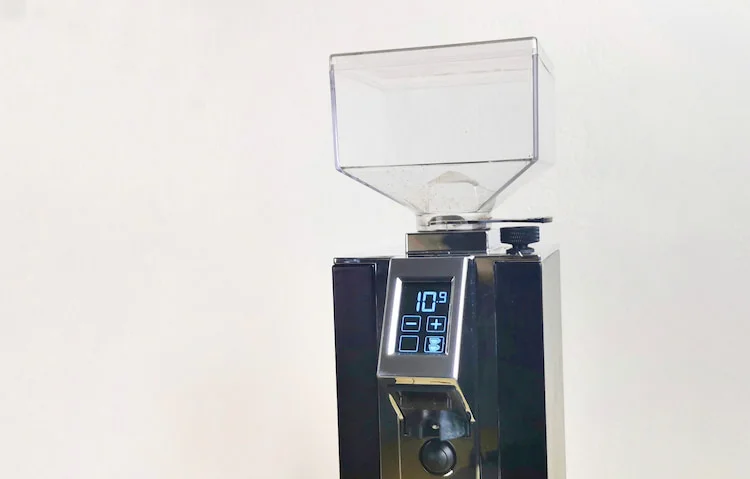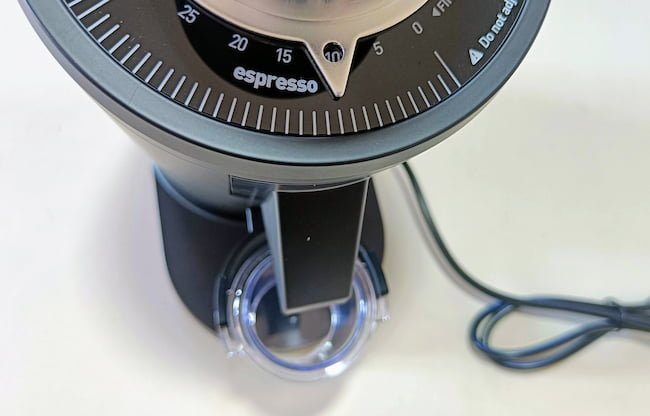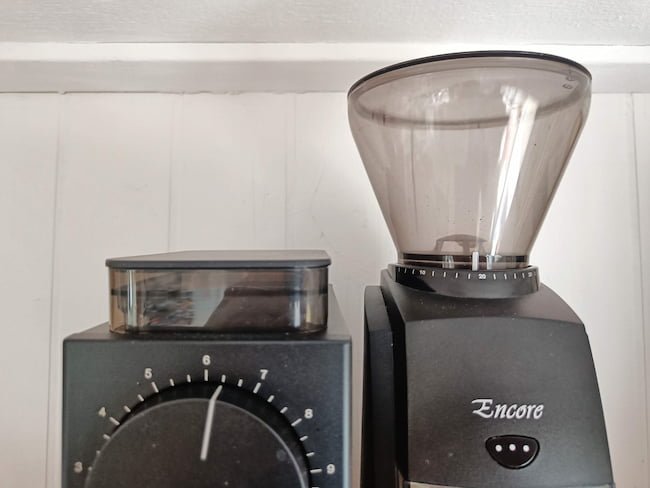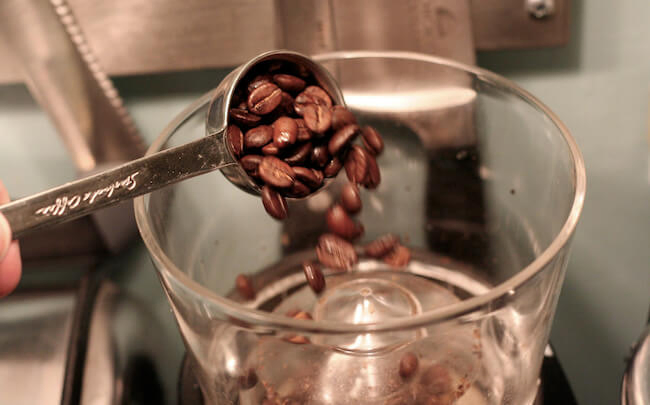In its simplest form, coffee dosing refers to measuring and grinding the right amount of coffee for your brewing method of choice.
However, one could argue that there is also a workflow aspect to coffee dosing.
And perhaps even a somewhat philosophical dimension 🤷♂️
Whether working with an espresso machine or a pour over setup, you should pay attention to dosing.
In this article, we’ll explore the different dosing methods, the importance of proper dosing, and how it connects to the distribution of coffee grounds.
⚠️ Heads-up: When used by coffee professionals, dosing does not generally refer to how much coffee you should use for a recipe: Instead dosing refers to how the dose is delivered.
For in-depth info about the correct amount of coffee you need for a given recipe or brew method, check out my article about coffee-to-water ratios.
However, here’s a quick reference chart if you’re unsure about the dose you need for a brewing method.
| Brewing Method | Gram Dose (1 Cup) | Tbsp (1 Cup) | Cup size | Ideal Brew Ratio |
|---|---|---|---|---|
| Espresso | 7 g | 1.4 tbsp | 21 ml | 1:3 |
| Moka Pot | 6.25 g | 1.25 tbsp | 50 ml | 1:8 |
| AeroPress | 16 g | 3.2 tbsp | 225 ml | 1:14 |
| French Press | 10.5 g | 2.1 tbsp | 147 ml | 1:14 |
| Chemex | 10 g | 2 tbsp | 147 ml | 1:15 |
| Pour Over | 15 g | 3 tbsp | 225 ml | 1:15 |
| Drip Coffee | 11 g | 2.2 tbsp | 177 ml | 1:16 |
Why is Coffee Dosing Important?
Dosing plays a critical role in both the workflow and consistency of your brewing process. Here’s why:
Workflow Efficiency: An easy and reliable dosing system allows you to maintain a smooth workflow.
Consistency: With a reliable dosing system, you can achieve the same input every time, leading to a more repeatable extraction. Then you only have to control the output, which is easily done with a digital scale.
Cleanliness: Dosing also impacts the cleanliness of your coffee-making process. Some grinders dose in a messy way, causing grinds to spill onto your counter instead of neatly landing in your portafilter.
Here are some indispensable dosing tools. These can help your workflow whether you’re single dosing or using a hopper.
- Dosing funnels: These sit on top of the portafilter and help direct the grinds into the basket, preventing spills.
(They are also handy if you plan to do WDT; otherwise, things can quickly become messy.) - Dosing cups: Designed to fit perfectly on 58 mm baskets, these cups catch the grinds as they come out of the grinder chute. Then, you place the portafilter on the cup and flip both while quickly shaking to dislodge any stuck coffee particles. This motion also gives you a head start on the distribution.
The Evolution of Coffee Dosing Methods
Coffee dosing has come a long way since the “old days.”
Since most espresso was mainly brewed in cafés, traditional dosing methods were based on high volume and efficiency.
For this reason, the big hopper filled with the espresso house blend was the standard everywhere you went.
A popular subset of hopper-based dosing is the notorious manual doser.
This rather old-fashioned contraption is attached to the grinder chute. It allows the user to grind into a larger chamber with many small compartments. Once full, a handle sweep dispenses a portion of coffee grounds with each pull.
Doser grinders were once the industry standard. Their ability to dose consistent amounts of coffee made them suitable for high-volume situations where efficiency is crucial.
However, their popularity has declined with advancements in technology and changing preferences.

Doserless or on-demand grinders have become more prevalent for home use and specialty coffee shops in recent years. These models grind directly into the portafilter or a container, eliminating the problem of stale coffee in the doser. This also gives greater flexibility in dose adjustment.
In both commercial and domestic settings, you’ll see weight-based dosing. This means the grinder will start and stop based on how much coffee you want in the portafilter.
Others, such as the Eureka Mignon Specialita, have timer-based dosing. This can work almost as well, depending on the manufacturer. Some timers are precise down to a tenth of a second. However, when you change the coffee blend, you’ll need to readjust the timer since the density of the beans will most likely be different.
For people who brew espresso at home and are not switching between many types of coffee, hopper-based dosing makes of sense.
However, many home espresso geeks now see this method as wasteful and better suited for the busy coffee shop.
And this leads us to the new approach that is all the rage today: single dosing.
Single Dosing: The Modern Way

Single dosing is a more mindful and precise way to grind coffee beans.
Instead of relying on a hopper, you weigh out the exact amount of beans you need and add them to your grinder.
The argument for this workflow is that it gives you fresher coffee and makes switching between many different types of beans more convenient. Since you don’t have to “purge” old coffee, this approach is less wasteful.
You will need a digital scale for single dosing; a scoop isn’t precise enough to work consistently.
Since single-dosing is a somewhat different workflow from hopper-based, and many new grinders created for this method have emerged over the last couple of years.
Single-doser grinders should have low retention, meaning that only a tiny amount of grounds (less than 0.5-0.1 grams) will be left in the chute or grind chamber. Bellows may further reduce retention by blowing out the last bit of retained grounds.
Single-dose grinders often have a small and specifically designed hopper to minimize the “popcorning” effect, where beans jump around due to the lack of weight from other beans.
Niche Zero was the first hugely successful single-dose grinder, but since then, many others have entered the market: The DF64 and Fellow Ode are some of the most prominent ones.
While single dosing for espresso is a slightly newer fad, single-dosing for brewed coffee has probably been more common among home users than most people realize. Even though basic domestic grinders such as the Bodum Bistro and Baratza Encore have hoppers, I bet many people never used them.
Remember that most manual grinders are more or less “single dosing” by default since they can usually only hold a small number of beans. So single dosing is not as radical as it sounds at first.

Espresso Dosing & Recipes
In espresso-making, dosing typically refers to the weight of coffee used.
- Traditionally, a single dose was 7-9 grams
- A double dose was 14-18 grams. Nowadays, double doses are virtually the standard among espresso enthusiasts, and the size has increased with baristas sometimes brewing 21 grams in one shot.
Dosing in espresso is closely related to the basket used (it should be the correct size). While you can still get single-dose baskets, they have largely fallen out of favor with home users.
The so-called espresso recipe, which considers input, output, and extraction time, is a slightly more advanced concept.
This is because extraction time is related to grind size and the desired output. And, of course, a recipe should also factor taste into the equation. Dosing is more about practical stuff and logistics.
Dosing Drip Coffee
Dosing drip coffee can quickly become a bit of an afterthought compared to all the technical aspects of dosing espresso.
When it comes to drip (and really all other methods besides espresso), single dosing is the way to go.
However, it’s still worth considering the different options and accessories you have available. Using a special contraption for weighing and loading the beans into the grinder can be a good idea.
I adore the silicone AeroPress Go cup cap for this purpose since it can also act as a funnel when squeezed together. This makes it easy to load beans anywhere, even into the narrow opening of a manual coffee grinder.
When discussing dosing for regular coffee, we quickly enter the territory of brew ratios or coffee-to-water ratios. Again, this is a bit of a different discussion, and I have an entire post dedicated to this that you should check out for a deeper explanation.
Brewed coffee doses/recipes are expressed as ratios. For example, 1:15, means that for each unit of coffee, you will use 15 units of water.
Espresso is a bit different since you don’t count the water that’s stuck in the puck. So 1:3 in an espresso context means that the total volume of the espresso shot is three times the dose.
Common espresso ratios
- 1:1 Ristretto
- 1:2 Normale
- 1:3 Long espresso shot (longer than this, and we’re getting into lungo territory).
Common Coffee Doses in Tablespoons (tbsp) and Grams (g)
It’s important to note that the amount of coffee used can vary depending on personal preferences and the specific brewing method. However, here are some general guidelines for dosing coffee:
- 1 tbsp of coffee grounds = approximately 5 grams
- 2 tbsp of coffee grounds = approximately 10 grams
- 4 tbsp of coffee grounds = approximately 20 grams
Remember that these measurements are approximate and can vary based on factors such as the type of coffee bean and grind size.
To achieve the most accurate dose, it’s best to use a scale to measure your coffee grounds by weight.
Wrap up
In conclusion, understanding coffee dosing is essential for achieving a consistent and enjoyable coffee experience.
Using the correct tools and techniques ensures that your coffee brewing process is streamlined, clean, and efficient. With practice and attention to detail, you’ll be well on your way to mastering the art of coffee dosing.
Top Featured Image: David Joyce | Source: Flickr CC

